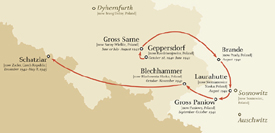Salaís Labor Camps
 Map illustrating the sequence and duration of
Map illustrating the sequence and duration of
Sala Garncarzís
imprisonment
The pace of deportation increased dramatically in 1942. On August
12, according to eyewitnesses, some 50,000 Jews from the Sosnowitz
region were herded into a sports field where they stood for days
in summer heat without food while the Nazis carried out a gigantic
selection. Those with local employment papers, like Sala’s
sister Laja Dina Krzesiwo and her family, were allowed to return
home; some, including Sala’s sisters Raizel and Blima, were
sent to slave labor camps. Sala’s parents were among the
thousands of other Jews—the elderly, the infirm, and children—who
were sent to their deaths at Auschwitz.
From June to December 1942, Sala
was transferred five times, never farther than
a few hours from Sosnowitz. Her survival skills had been
honed from the
time of her first experience at Geppersdorf —and
she was lucky. People liked her, and some of the Nazi guards
helped her. Even so, each transfer endangered her letters
and required
a new hiding place. During searches, she handed her bundle
of letters to friends, buried them, or hid them in her clothing.
Raizel was able to continue writing from a slave labor camp at
Neusalz, where she and Blima worked in a cotton-processing plant.
And Ala wrote from Bendsburg and Sosnowitz, upbeat and positive,
ever the mentor, until just before the ghettos were liquidated
on August 1, 1943, and the remainder of the Jews were deported.
The head of the Judenrat,
Moshe Merin, had already been sent to Auschwitz, on June 19.
Organization Schmelt was
shut down, and its camps were merged into the concentration camps
of Auschwitz
and Gross
Rosen. Albrecht Schmelt retired to his country estate.